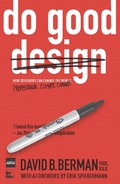“an emerging synthesis of artist, inventor, mechanic, objective economist and evolutionary strategist.” | ||
| --BUCKMINSTER FULLER (1895–1983) | ||
IN THE YEAR 2000, I sold the successful graphic design agency I had founded at the age of 22. I chose a new career path, to achieve a balance between working for clients who are helping repair the world and sharing how to do that with others.
This book is a reflection of that quest. Its message is for designers, for those who buy design, and for those who consume design.
Graphic designers (some say “communication designers”)[4] create a bridge between information and understanding. Industrial designers add usability and appeal to objects. Interior designers invent where we live.
Designers have an essential social responsibility because design is at the core of the world’s largest challenges... and solutions. Designers create so much of the world we live in, the things we consume, and the expectations we seek to fulfill. They shape what we see, what we use, and what we waste. Designers have enormous power to influence how we engage our world, and how we envision our future. How much power? I intend to shock you.
Everyone is now a designer. We live in an era that encourages us to develop our very own personalized interfaces with the world. Each time you resize your Web browser window, DVR your television programming, build an MP3 playlist, or customize a ringtone, you join a design team. Add in the crowdsourcing technologies of Web 2.0, and your role becomes far broader. Indeed, I believe that the future of our world is now our common design project.
Those who know me are aware that until now I’ve been a designer, a strategist, an expert speaker on a mission... but not a book author. Within the low-tech medium of a book, I’m told that, no matter how intrigued you may be with these words and pictures, there is over a 70 percent chance that you won’t read it cover to cover. And I can’t corner you in the hallway later, as I could if you slipped out on one of my presentations. Because you may wander from this book and unintentionally never return, I want to share the essence of my argument right now.
So before you get distracted by your iPod, a Twitter, or someone phones or texts you, here are the core thoughts:
Designers have far more power than they realize: their creativity fuels the most efficient (and most destructive) tools of deception in human history.
The largest threat to humanity’s future just may be the consumption of more than necessary. We are caught up in an unsustainable frenzy, spurred by rapid advances in the sophistication, psychology, speed, and reach of visual lies designed to convince us we “need” more stuff than we really do.
Human civilization, trending toward one global civilization, cannot afford to make even one more major global goof.
The same design that fuels mass overconsumption also holds the power to repair the world.
We live in an unprecedented technological age, where we can each leave a larger legacy by propagating our best ideas than by propagating our chromosomes.
Designers can be a model for other professionals for identifying one’s sphere of influence, and then embrace the responsibility that accompanies that power to help repair the world.
So don’t just do good design, do good.
I am going to share with you how we can use design to help repair (or destroy) our civilization. The specifics are pertinent to all design and communications fields, while the principles of how one can make a difference are transferable to any profession. With my graphic design background, I draw most of my examples from what I know best: graphic design, advertising, and branding.
There has never been a better nor more important time to discuss responsible design. Back in 2002, I had my first chance to speak outside my native Canada, at an international design conference in the Czech Republic. My How Logo Can We Go? speech was a maverick[5] presentation, the only one about socially responsible design. Just five years later, in October 2007, I moderated the social responsibility themed day at the Icograda World Design Congress in Cuba, and almost every speaker every day tied their work to the difference that designers can make for the world. In 20 countries, I’ve seen, heard, and felt the change that is in motion globally. But will the shift be too little, too late?
Designers who publish books usually show you their designs. But in this volume, I’ll instead focus on the work of others: some of the most influential design of our age. While you probably won’t know the designers’ names, you will recognize their work.
At the end, I will make an appeal to your true self. Don’t panic: I won’t ask you to give up your job, earn less money, or even have less fun. I will ask you to commit to becoming part of the solution.
If you’re already convinced but short on time, then skip now to the pledge on page 146.
Otherwise, as with most design problems, the place to start is in defining the goals, challenges, and constraints: doing so is typically more than half the solution. So here follows the “creative brief” for the design challenge of our lifetimes.
